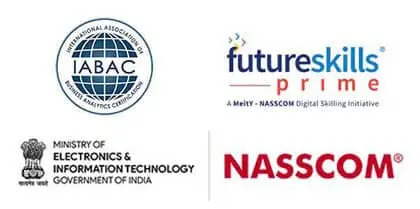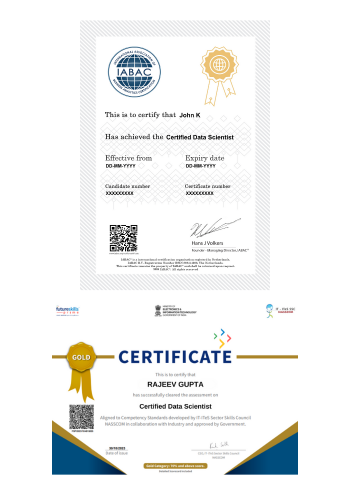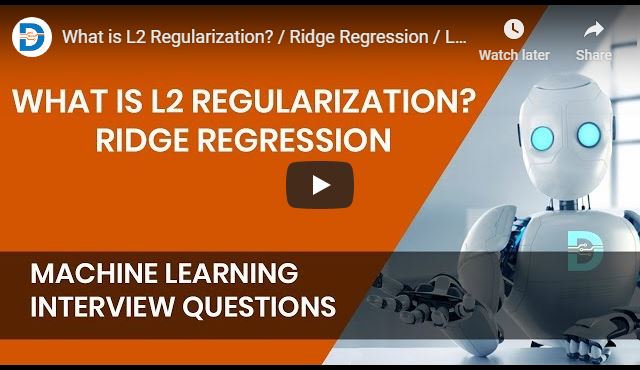Instructor Led Live Online
Self Learning + Live Mentoring
In - Person Classroom Training
The entire training includes real-world projects and highly valuable case studies.
IABAC® certification provides global recognition of the relevant skills, thereby opening opportunities across the world.
MODULE 1: DATA SCIENCE ESSENTIALS
• Introduction to Data Science
• Evolution of Data Science
• Big Data Vs Data Science
• Data Science Terminologies
• Data Science vs AI/Machine Learning
• Data Science vs Analytics
MODULE 2: DATA SCIENCE DEMO
• Business Requirement: Use Case
• Data Preparation
• Machine learning Model building
• Prediction with ML model
• Delivering Business Value.
MODULE 3: ANALYTICS CLASSIFICATION
• Types of Analytics
• Descriptive Analytics
• Diagnostic Analytics
• Predictive Analytics
• Prescriptive Analytics
• EDA and insight gathering demo in Tableau
MODULE 4: DATA SCIENCE AND RELATED FIELDS
• Introduction to AI
• Introduction to Computer Vision
• Introduction to Natural Language Processing
• Introduction to Reinforcement Learning
• Introduction to GAN
• Introduction to Generative Passive Models
MODULE 5: DATA SCIENCE ROLES & WORKFLOW
• Data Science Project workflow
• Roles: Data Engineer, Data Scientist, ML Engineer and MLOps Engineer
• Data Science Project stages.
MODULE 6: MACHINE LEARNING INTRODUCTION
• What Is ML? ML Vs AI
• ML Workflow, Popular ML Algorithms
• Clustering, Classification And Regression
• Supervised Vs Unsupervised
MODULE 7: DATA SCIENCE INDUSTRY APPLICATIONS
• Data Science in Finance and Banking
• Data Science in Retail
• Data Science in Health Care
• Data Science in Logistics and Supply Chain
• Data Science in Technology Industry
• Data Science in Manufacturing
• Data Science in Agriculture
MODULE 1: PYTHON BASICS
• Introduction of python
• Installation of Python and IDE
• Python Variables
• Python basic data types
• Number & Booleans, strings
• Arithmetic Operators
• Comparison Operators
• Assignment Operators
MODULE 2: PYTHON CONTROL STATEMENTS
• IF Conditional statement
• IF-ELSE
• NESTED IF
• Python Loops basics
• WHILE Statement
• FOR statements
• BREAK and CONTINUE statements
MODULE 3: PYTHON DATA STRUCTURES
• Basic data structure in python
• Basics of List
• List: Object, methods
• Tuple: Object, methods
• Sets: Object, methods
• Dictionary: Object, methods
MODULE 4: PYTHON FUNCTIONS
• Functions basics
• Function Parameter passing
• Lambda functions
• Map, reduce, filter functions
MODULE 1: OVERVIEW OF STATISTICS
• Introduction to Statistics
• Descriptive And Inferential Statistics
• Basic Terms Of Statistics
• Types Of Data
MODULE 2: HARNESSING DATA
• Random Sampling
• Sampling With Replacement And Without Replacement
• Cochran's Minimum Sample Size
• Types of Sampling
• Simple Random Sampling
• Stratified Random Sampling
• Cluster Random Sampling
• Systematic Random Sampling
• Multi stage Sampling
• Sampling Error
• Methods Of Collecting Data
MODULE 3: EXPLORATORY DATA ANALYSIS
• Exploratory Data Analysis Introduction
• Measures Of Central Tendencies: Mean,Median And Mode
• Measures Of Central Tendencies: Range, Variance And Standard Deviation
• Data Distribution Plot: Histogram
• Normal Distribution & Properties
• Z Value / Standard Value
• Empirical Rule and Outliers
• Central Limit Theorem
• Normality Testing
• Skewness & Kurtosis
• Measures Of Distance: Euclidean, Manhattan And Minkowski Distance
• Covariance & Correlation
MODULE 4: HYPOTHESIS TESTING
• Hypothesis Testing Introduction
• P- Value, Critical Region
• Types of Hypothesis Testing
• Hypothesis Testing Errors : Type I And Type II
• Two Sample Independent T-test
• Two Sample Relation T-test
• One Way Anova Test
• Application of Hypothesis testing
MODULE 1: MACHINE LEARNING INTRODUCTION
• What Is ML? ML Vs AI
• Clustering, Classification And Regression
• Supervised Vs Unsupervised
MODULE 2: PYTHON NUMPY PACKAGE
• Introduction to Numpy Package
• Array as Data Structure
• Core Numpy functions
• Matrix Operations, Broadcasting in Arrays
MODULE 3: PYTHON PANDAS PACKAGE
• Introduction to Pandas package
• Series in Pandas
• Data Frame in Pandas
• File Reading in Pandas
• Data munging with Pandas
MODULE 4: VISUALIZATION WITH PYTHON - Matplotlib
• Visualization Packages (Matplotlib)
• Components Of A Plot, Sub-Plots
• Basic Plots: Line, Bar, Pie, Scatter
MODULE 5: PYTHON VISUALIZATION PACKAGE - SEABORN
• Seaborn: Basic Plot
• Advanced Python Data Visualizations
MODULE 6: ML ALGO: LINEAR REGRESSSION
• Introduction to Linear Regression
• How it works: Regression and Best Fit Line
• Modeling and Evaluation in Python
MODULE 7: ML ALGO: LOGISTIC REGRESSION
• Introduction to Logistic Regression
• How it works: Classification & Sigmoid Curve
• Modeling and Evaluation in Python
MODULE 8: ML ALGO: K MEANS CLUSTERING
• Understanding Clustering (Unsupervised)
• K Means Algorithm
• How it works : K Means theory
• Modeling in Python
MODULE 9: ML ALGO: KNN
• Introduction to KNN
• How It Works: Nearest Neighbor Concept
• Modeling and Evaluation in Python
MODULE 1: FEATURE ENGINEERING
• Introduction to Feature Engineering
• Feature Engineering Techniques: Encoding, Scaling, Data Transformation
• Handling Missing values, handling outliers
• Creation of Pipeline
• Use case for feature engineering
MODULE 2: ML ALGO: SUPPORT VECTOR MACHINE (SVM)
• Introduction to SVM
• How It Works: SVM Concept, Kernel Trick
• Modeling and Evaluation of SVM in Python
MODULE 3: PRINCIPAL COMPONENT ANALYSIS (PCA)
• Building Blocks Of PCA
• How it works: Finding Principal Components
• Modeling PCA in Python
MODULE 4: ML ALGO: DECISION TREE
• Introduction to Decision Tree & Random Forest
• How it works
• Modeling and Evaluation in Python
MODULE 5: ENSEMBLE TECHNIQUES - BAGGING
• Introduction to Ensemble technique
• Bagging and How it works
• Modeling and Evaluation in Python
MODULE 6: ML ALGO: NAÏVE BAYES
• Introduction to Naive Bayes
• How it works: Bayes' Theorem
• Naive Bayes For Text Classification
• Modeling and Evaluation in Python
MODULE 7: GRADIENT BOOSTING, XGBOOST
• Introduction to Boosting and XGBoost
• How it works?
• Modeling and Evaluation of in Python
MODULE 1: TIME SERIES FORECASTING - ARIMA
• What is Time Series?
• Trend, Seasonality, cyclical and random
• Stationarity of Time Series
• Autoregressive Model (AR)
• Moving Average Model (MA)
• ARIMA Model
• Autocorrelation and AIC
• Time Series Analysis in Python
MODULE 2: SENTIMENT ANALYSIS
• Introduction to Sentiment Analysis
• NLTK Package
• Case study: Sentiment Analysis on Movie Reviews
MODULE 3: REGULAR EXPRESSIONS WITH PYTHON
• Regex Introduction
• Regex codes
• Text extraction with Python Regex
MODULE 4: ML MODEL DEPLOYMENT WITH FLASK
• Introduction to Flask
• URL and App routing
• Flask application – ML Model deployment
MODULE 5: ADVANCED DATA ANALYSIS WITH MS EXCEL
• MS Excel core Functions
• Advanced Functions (VLOOKUP, INDIRECT..)
• Linear Regression with EXCEL
• Data Table
• Goal Seek Analysis
• Pivot Table
• Solving Data Equation with EXCEL
MODULE 6: AWS CLOUD FOR DATA SCIENCE
• Introduction of cloud
• Difference between GCC, Azure, AWS
• AWS Service ( EC2 instance)
MODULE 7: AZURE FOR DATA SCIENCE
• Introduction to AZURE ML studio
• Data Pipeline
• ML modeling with Azure
MODULE 8: INTRODUCTION TO DEEP LEARNING
• Introduction to Artificial Neural Network, Architecture
• Artificial Neural Network in Python
• Introduction to Convolutional Neural Network, Architecture
• Convolutional Neural Network in Python
MODULE 1: DATABASE INTRODUCTION
• DATABASE Overview
• Key concepts of database management
• Relational Database Management System
• CRUD operations
MODULE 2: SQL BASICS
• Introduction to Databases
• Introduction to SQL
• SQL Commands
• MY SQL workbench installation
MODULE 3: DATA TYPES AND CONSTRAINTS
• Numeric, Character, date time data type
• Primary key, Foreign key, Not null
• Unique, Check, default, Auto increment
MODULE 4: DATABASES AND TABLES (MySQL)
• Create database
• Delete database
• Show and use databases
• Create table, Rename table
• Delete table, Delete table records
• Create new table from existing data types
• Insert into, Update records
• Alter table
MODULE 5: SQL JOINS
• Inner Join, Outer Join
• Left Join, Right Join
• Self Join, Cross join
• Windows function: Over, Partition, Rank
MODULE 6: SQL COMMANDS AND CLAUSES
• Select, Select distinct
• Aliases, Where clause
• Relational operators, Logical
• Between, Order by, In
• Like, Limit, null/not null, group by
• Having, Sub queries
MODULE 7 : DOCUMENT DB/NO-SQL DB
• Introduction of Document DB
• Document DB vs SQL DB
• Popular Document DBs
• MongoDB basics
• Data format and Key methods
MODULE 1: GIT INTRODUCTION
• Purpose of Version Control
• Popular Version control tools
• Git Distribution Version Control
• Terminologies
• Git Workflow
• Git Architecture
MODULE 2: GIT REPOSITORY and GitHub
• Git Repo Introduction
• Create New Repo with Init command
• Git Essentials: Copy & User Setup
• Mastering Git and GitHub
MODULE 3: COMMITS, PULL, FETCH AND PUSH
• Code Commits
• Pull, Fetch and Conflicts resolution
• Pushing to Remote Repo
MODULE 4: TAGGING, BRANCHING AND MERGING
• Organize code with branches
• Checkout branch
• Merge branches
• Editing Commits
• Commit command Amend flag
• Git reset and revert
MODULE 5: GIT WITH GITHUB AND BITBUCKET
• Creating GitHub Account
• Local and Remote Repo
• Collaborating with other developers
MODULE 1: BIG DATA INTRODUCTION
• Big Data Overview
• Five Vs of Big Data
• What is Big Data and Hadoop
• Introduction to Hadoop
• Components of Hadoop Ecosystem
• Big Data Analytics Introduction
MODULE 2 : HDFS AND MAP REDUCE
• HDFS – Big Data Storage
• Distributed Processing with Map Reduce
• Mapping and reducing stages concepts
• Key Terms: Output Format, Partitioners,
• Combiners, Shuffle, and Sort
MODULE 3: PYSPARK FOUNDATION
• PySpark Introduction
• Spark Configuration
• Resilient distributed datasets (RDD)
• Working with RDDs in PySpark
• Aggregating Data with Pair RDDs
MODULE 4: SPARK SQL and HADOOP HIVE
• Introducing Spark SQL
• Spark SQL vs Hadoop Hive
MODULE 1: TABLEAU FUNDAMENTALS
• Introduction to Business Intelligence & Introduction to Tableau
• Interface Tour, Data visualization: Pie chart, Column chart, Bar chart.
• Bar chart, Tree Map, Line Chart
• Area chart, Combination Charts, Map
• Dashboards creation, Quick Filters
• Create Table Calculations
• Create Calculated Fields
• Create Custom Hierarchies
MODULE 2: POWER-BI BASICS
• Power BI Introduction
• Basics Visualizations
• Dashboard Creation
• Basic Data Cleaning
• Basic DAX FUNCTION
MODULE 3 : DATA TRANSFORMATION TECHNIQUES
• Exploring Query Editor
• Data Cleansing and Manipulation:
• Creating Our Initial Project File
• Connecting to Our Data Source
• Editing Rows
• Changing Data Types
• Replacing Values
MODULE 4: CONNECTING TO VARIOUS DATA SOURCES
• Connecting to a CSV File
• Connecting to a Webpage
• Extracting Characters
• Splitting and Merging Columns
• Creating Conditional Columns
• Creating Columns from Examples
• Create Data Model
To enroll in a data science course, specific qualifications or prior programming experience are generally not required. However, having a programming background can be advantageous. A strong desire to learn and dedication to the field are crucial for a successful career in data science.
Data science courses in Bareilly generally range from 4 to 12 months, depending on the depth and format of the program, such as full-time, part-time, or online options.
Entry-level data scientists in Bareilly can expect a starting salary between INR 3 to INR 7 lakhs per annum, varying based on skills and company size.
The scope of data science in Bareilly is expanding, with increasing demand across sectors like healthcare, finance, and retail, offering significant growth opportunities.
The best data science course in Bareilly depends on your personal goals and needs. It’s important to select a program with a robust curriculum, skilled instructors, and solid industry connections. DataMites offers a comprehensive data science course, complete with placement support, internships, and globally recognized certifications, having successfully trained over 70,000 students.
Coding is not a fundamental requirement for a career in data science however, having programming skills can significantly enhance your capabilities and open up more opportunities. While you can succeed without coding knowledge, proficiency in programming languages can provide a competitive edge in the field.
Absolutely! Individuals from various backgrounds, such as business or social sciences, can transition into data science by acquiring relevant skills through courses and practical experience.
A data science course typically covers topics like data analysis, machine learning, statistics, programming, and data visualization, along with practical projects to reinforce learning.
A data scientist is a professional who uses statistical analysis, programming skills, and domain knowledge to extract insights from data and inform decision-making.
To effectively learn data science in Bareilly, opt for accredited courses that offer hands-on projects. DataMites provides a comprehensive course with practical training and robust placement assistance. Additionally, offline classes are available in major cities such as Bangalore, Mumbai, Pune, Hyderabad, and Chennai.
A career in data science benefits from skills like coding and data visualization, though there is no fixed set of essential skills. Familiarity with programming languages and the ability to present data effectively can enhance your capabilities in this field.
Yes, there is a robust demand for data scientists across various industries, driven by the increasing importance of data-driven decision-making.
Common challenges include dealing with unstructured data, ensuring data quality, and effectively communicating complex results to non-technical stakeholders.
Career prospects in data science are promising, with roles such as data analyst, data engineer, and machine learning engineer, alongside potential leadership positions.
Yes, data science is considered a stable career choice due to its growing demand and the critical role data plays in strategic business decisions.
Acquiring data science knowledge enhances analytical skills, opens up diverse career opportunities, and enables individuals to contribute to data-driven decision-making processes.
Yes, data science can be challenging due to its technical nature and the need for continuous learning to keep up with evolving tools and technologies.
Commonly used tools in data science include Python, R, SQL, Tableau, and various machine learning libraries like TensorFlow and Scikit-learn.
Both Python and R have their strengths; Python is favored for its versatility and ease of use in deployment, while R is preferred for statistical analysis and visualization.
Data scientists in Bareilly should possess a strong understanding of business fundamentals, market trends, and the ability to translate data insights into actionable business strategies.
To enroll in the Data Science course, visit our website, fill out the application form, and our team will guide you through the next steps.
Our Data Science courses in Bareilly offer practical experience through 25 capstone projects and one client project. This hands-on approach ensures that you gain valuable skills applicable in real-world scenarios. Join us to enhance your learning with these valuable projects.
Students receive comprehensive course materials, including textbooks, online resources, and access to our learning management system.
Upon completing the course, you will earn certifications from DataMites, IABAC®, and NASSCOM® FutureSkills certification. These credentials validate your expertise in Data Science and are well-regarded in the industry. Equip yourself with recognized certifications to advance your career.
Yes, we provide placement assistance to our students, helping them connect with potential employers after course completion.
Yes, our Data Science course includes internship opportunities that allow students to gain practical experience in the field.
The DataMites Data Science course in Bareilly provides flexible fee options to suit different preferences. Live online training is priced at INR 68,900, while blended learning is available for INR 41,900. For the most current details, please visit the DataMites website or contact our support team.
At DataMites, our head trainer is Ashok Veda the CEO of Rubixe. Our trainers bring a wealth of industry experience in data science, providing students with practical knowledge and valuable insights. This ensures a comprehensive learning experience throughout the course.
Yes, we offer demo classes so prospective students can experience our teaching methodology before making a commitment.
Yes, we provide options for students to make up missed sessions, ensuring they stay on track with their learning.
Our refund policy is outlined in our terms and conditions please refer to our website or contact support for specific details.
The Flexi-Pass offers 3 months of flexible access to DataMites courses, enabling learners to select and switch between various subjects. This feature is designed to cater to diverse learning preferences and schedules, providing a tailored educational experience. Enjoy the freedom to customize your learning journey by exploring multiple topics.
Yes, Datamites offers an EMI option for their Data Science courses in Bareilly. They accept payments by credit card, debit card, and online payment methods. This makes it flexible and convenient for learners.
Our syllabus covers key topics such as statistics, machine learning, data visualization, and more to ensure a comprehensive learning experience.
To enroll, visit our website, fill out the application form, and our team will assist you throughout the enrollment process.
The DataMites Placement Assistance Team(PAT) facilitates the aspirants in taking all the necessary steps in starting their career in Data Science. Some of the services provided by PAT are: -
The DataMites Placement Assistance Team(PAT) conducts sessions on career mentoring for the aspirants with a view of helping them realize the purpose they have to serve when they step into the corporate world. The students are guided by industry experts about the various possibilities in the Data Science career, this will help the aspirants to draw a clear picture of the career options available. Also, they will be made knowledgeable about the various obstacles they are likely to face as a fresher in the field, and how they can tackle.
No, PAT does not promise a job, but it helps the aspirants to build the required potential needed in landing a career. The aspirants can capitalize on the acquired skills, in the long run, to a successful career in Data Science.











